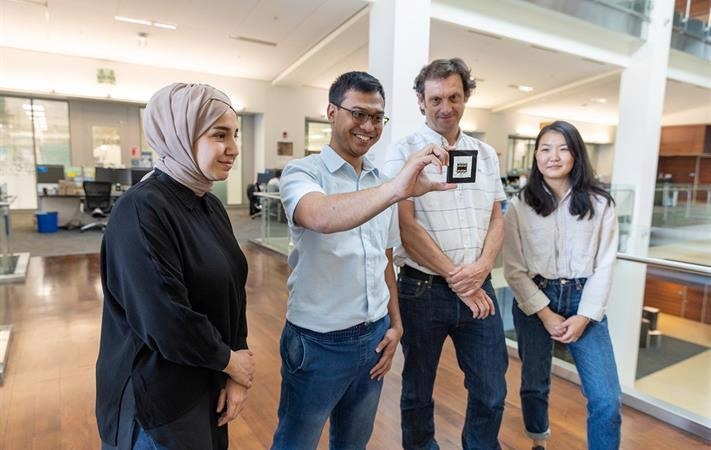Renewable technologies, such as solar and wind power, are leading areas of interest for research as environment protection and renewable energy global trends influence how humans approach energy strategies toward a green and peaceful future for the planet.
 From left to right: Dr. Esma Ugur, Dr. Randi Azmi, Prof. Stefaan De Wolf, and Dr. Akmaral Seitkhan. Image Credit: King Abdullah University of Science and Technology.
From left to right: Dr. Esma Ugur, Dr. Randi Azmi, Prof. Stefaan De Wolf, and Dr. Akmaral Seitkhan. Image Credit: King Abdullah University of Science and Technology.
The emerging area of perovskite solar cells (PSCs) has grown in popularity in the solar tech sector over the last decade and a half for providing excellent power conversation efficiencies (PCEs).
However, in a market dominated by silicon solar cells, the fairly modern technology must also encounter two other requirements for commercialization: stability and expandability.
The first successful photovoltaic (PV) damp-heat evaluation of PSCs by KAUST researchers marked a major turning point. The study was published in the Science journal.
The damp-heat test is an expedited and rigorous environmental aging test designed to determine solar panels’ capacity to endure sustained exposure to elevated humidity penetration and elevated temperatures. The test is carried out for 1,000 hours in a controlled setting with 85% humidity and 85 °C temperature. It is designed to simulate multiple years of outdoor exposure and assess aspects such as corrosion and delamination.
Passing the Test
The test’s rigor is in line with commercialization requirements, which state that PV technology must provide a 25- to 30-year warranty for traditional crystalline-silicon modules. To pass the test, the solar cell must sustain 95% of its initial performance.
Their research, led by first author Randi Azmi, a postdoctoral fellow in Professor Stefaan De Wolf’s KAUST Photovoltaics Laboratory, had to overcome an everlasting vulnerability in entrapped PSCs to prevent packaging leakage.
Perovskites, which are implemented through a thin-film surface coating, are sensitive to humidity and are significantly affected by it. This vulnerability of 3D perovskite films enables unnecessary infiltration of atmospheric substances, such as moisture, despite their limited heat resistance. Stability is critical to their operation.
KAUST researchers discovered that engineering and inserting 2D-perovskite passivation layers blocked moisture while also improving energy conversion efficiency and lifetime PSCs.
Can Perovskites Replace Silicon?
The thin-film technology of perovskites sets them apart. As with traditional solar cells, two contacts made of specific materials are still needed. One collects electrons, while the other gathers positively charged “holes,” which portray electron exclusion.
Perovskite ink, unlike silicon wafers, can be coated instantly on a glass substrate, preceded by antisolvent extraction and thermal annealing to completely crystallize the perovskite film. Perovskite ink is primarily made by combining salts in a polar aprotic solvent at a low temperature (usually lower than 100 °C).
One of the major benefits is that precursor materials can be produced without the need for costly facilities or energy-intensive surroundings exceeding 1,000 °C, as is common for more conventional semiconductors such as silicon.
It’s a very simple way to make solar cells. While the optoelectronic properties are not unique, they are excellent. They’re on-par with very high-quality traditional semiconductors. That’s quite remarkable.
Stefaan De Wolf, Professor, Photovoltaics Laboratory, King Abdullah University of Science and Technology
He claims that by changing the composition, he can tune the spectral sensitivity across the solar light spectrum, from UV to infrared. “This is quite attractive for certain applications,” De Wolf added.
After efficiency and robustness, the final task is scaling. The majority of solar cell applications are concentrated in utility-scale sectors and rooftop panels. While the latter is not widely used in Saudi Arabia, utility projects in the country include large PV fields in the desert.
The market is silicon-based, and it will be silicon-based for the next 20 years at least.
Stefaan De Wolf, Professor, Photovoltaics Laboratory, King Abdullah University of Science and Technology
The KAUST Photovoltaics Lab is primarily concerned with boosting the effectiveness of perovskite solar cells in terms of developing more effective “tandem” solutions that combine conventional silicon and perovskite.
To that end, De Wolf believes the current findings will significantly enhance the credibility of perovskite-silicon tandem solar cells.
Journal Reference:
Azmi, R., et al. (2022) Damp heat–stable perovskite solar cells with tailored-dimensionality 2D/3D heterojunctions. Science. doi.org/10.1126/science.abm5784.